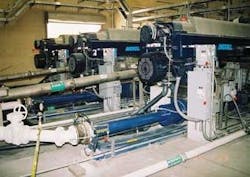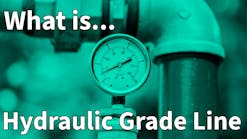A cutaway of the seepex BTH progressing cavity pump with in-line auger system.
Click here to enlarge imageThe feeding mechanisms in progressive cavity pumps have changed substantially over the last two decades and function is evolving in two different ways. One direction is toward more positive feeding and the other is toward higher shear forces to further reduce apparent viscosities.
PC pumps have many unique characteristics. The cavity created between the rotor and stator does not change its shape as it moves through the pump. It has no valves. It does not, inherently, pulsate. It has relatively low internal velocities because the rotating parts have relatively small diameters and it is a pump designed with a bearing on each end.
On the end with the motor, the pump has traditional tapered roller bearings, lubricated with oil or grease, like any other rotary pump. On the other end, the polished and hardened helical rotor is rotating inside a rubber-lined tube. In other applications, this is easily recognized as a marine bearing.
Rubber, with a liquid boundary layer, is amazingly slippery. Marine bearings are common in ships ranging from inboard ski boats to Dallas-class attack submarines. All PC pump manufacturers, at least in their early years, purchased stators from manufacturers of marine bearings.
This type of bearing is an excellent support for a feed and/or shearing auger used to enable the PC pump to handle sludge cake and other highly viscous products, without adding additional wearing parts or maintenance points. Sludge cake, even though it contains as much as 40 percent solids, still is mainly water and still maintains the lubricating qualities that allow the stator to operate as a marine bearing.
An easy way to improve the cake handling capabilities of the PC pump is to use the eccentrically rotating coupling rod and any attachments, like an auger, to more efficiently reduce the apparent viscosity of the cake so that higher viscosities and solids percentages can be pumped. By increasing the diameter of the auger and the extension tube so that it feeds at a rate of 200 percent, the cake is circulated and sheared a great deal prior to entry into the pumping element. This has been a common design for the last 10 years and has proven to be quite acceptable and reliable for handling the discharge from belt-filter presses at solids percentages approaching 30 percent.
The seepex feed system attaches a ribbon auger to a plate fixed to the pump drive shaft, behind the concentrically rotating universal joint. The system now allows PC pumps to easily handle biosolids up to 40 percent. The system is fabricated so that the hopper matches the discharge dimensions of the dewatering device. The auger feeds at almost five times the capacity of the rotor and stator. A thick urethane liner in the hopper of the pump supports the feeder. To date, none of the liners, with installations exceeding four years in operation, have ever required replacement.
A variant of the cake pump with a concentrically rotating auger has a separate variable speed drive dedicated to the auger. The auger can be used to feed material into the pumping cavity and also as a separate shear inducing or mixing device. The design can be used to add calcium oxide or calcium hydroxide for treating biosolids. Industrially, it has been used to handle pigments discharged from plate and frame filter presses that exceed 75 percent solids and to mix milled grains with hot water to prepare "wort" in breweries and distilleries.
The new inline auger feeder can help to reduce the apparent viscosity of the cake as well as feed it into the pump. The efficiency and characteristics of this feed device can define the character of the cake that is discharged into a storage or transport device. High shear feed devices will produce a cake that is temporarily a lower viscosity that may be aesthetically undesirable. Using equipment that is designed for higher capacities and will operate at lower speeds and shear rates can reduce this effect.
Using appropriate shearing and feeding devices, along with boundary layer injection systems, pressures can be minimized and cake can be pumped over substantially long distances, exceeding 2,000 feet, with relatively inexpensive, efficient and reliable equipment.
Visit seepex, Inc. at Booth 22127 Hall B to see application videos and more information. Or visit the company's website at www.seepex.com.




